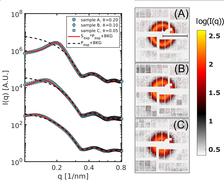I(q) (left) and speckle patterns (right) from the colloidal dispersions measured at European XFEL.
In our last paper we studied the many-body hydrodynamic interactions in a dense colloidal suspension with microsecond resolution at the European XFEL. Many soft matter systems are composed of macromolecules or nanoparticles suspended in water. The characteristic times at intrinsic length-scales of few nm fall therefore in the µs and sub-µs time regime. With the development of Free Electron Lasers (FEL) and 4th generation synchrotron light-sources, time resolved experiments in such time- and length-range will become routinely accessible in the near future. In the present work we report our findings on prototypical soft-matter systems, composed of charge-stabilized silica nanoparticles dispersed in water. The sample dynamics were probed by means of X-ray Photon Correlation Spectroscopy (XPCS) employing the MHz pulse repetition rate of the European XFEL and the Adaptive Gain Integrating Pixel Detector (AGIPD). We show that it is possible to correctly identify the dynamical properties (see also our method paper) that determine the diffusion constant, both for stationary samples and for systems driven by the XFEL pulses. Remarkably, despite the high photon density the only observable induced effect is the heating of the scattering volume meaning that all other X-ray induced effects do not influence the structure and the dynamics on the probed time-scales. Additionally, we illustrate how it is possible to control such induced heating and how it can be predicted with thermodynamic models.
IUCrJ 8, 755 (2021)
Applied Sciences 11, 8037 (2021)






